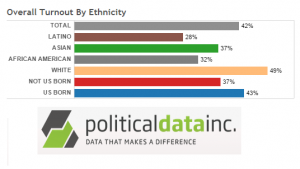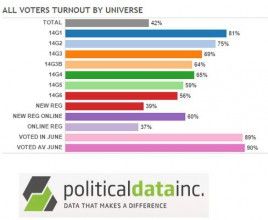Data show election participation varies greatly
 Just 42 percent of registered voters cast their ballots last November. But concentrating on that top-line number would be a mistake, said the state’s preeminent political data expert.
Just 42 percent of registered voters cast their ballots last November. But concentrating on that top-line number would be a mistake, said the state’s preeminent political data expert.
“Overall, the turnout data show that the surface totals, like saying it was 42 percent turnout, belie the fact that turnout is so varied by age and demographics,” Paul Mitchell, vice-president of Political Data, Inc., told CalWatchdog.com.
A new turnout analysis published by Mitchell’s firm shows wide disparities in voter participation throughout the state based on region, age, ethnicity and past voter history. These demographic factors offer a more complete picture of the lowest turnout general election in California’s history.
So, who voted? Despite their smaller registration numbers, Republicans turned out in higher percentages than Democrats or independent voters. Older Californians showed up at the polls in greater numbers than younger voters. Bay Area counties outperformed Southern California. White and Asian Americans voted in higher numbers than Latinos or African Americans.
Dig a little deeper, and you can identify smaller sub-groups of voters that are a virtual lock to cast their ballots. For example, here’s a fun stat: 90 percent of Republican voters over the age of 65 in Sierra County exercised their franchise in last November’s election.
Age: Older voters show up, younger voters don’t
 Before race or ethnicity, age offered the starkest contrast in turnout. Statewide, two-thirds of registered voters over the age of 65 cast their ballots.
Before race or ethnicity, age offered the starkest contrast in turnout. Statewide, two-thirds of registered voters over the age of 65 cast their ballots.
“Look at any district and the Age 65-plus cohort had turnout that is about 25 points higher and parallels their turnout in other gubernatorial elections,” Mitchell explained. “In a place like Huntington Beach, you see that age cohort at 72 percent turnout. Even in a low-income community like Santa Ana, nearly two-thirds of those voters cast ballots.”
Younger voters, who rocked the vote for Barack Obama in 2008 and 2012, weren’t nearly as enthused about the reelection of California’s 76-year-old Democratic governor, Jerry Brown. Just 17 percent of registered voters under the age of 30 voted.
“I think even folks that work with the data all the time were surprised by just how low that number was,” Mindy Romero, director of the California Civic Engagement Project at the University of California, Davis, told KQED. “Youth get very little contact, real contact, from candidates and campaigns. And so it generates even less information, less awareness, less connection with the political process.”
34th State Senate: Lower Latino turnout
In the competitive 34th state Senate district, Republican Janet Nguyen cruised to victory with the help of Asian voters, who overwhelmingly voted by mail. In her battle against former Democratic Assemblyman Jose Solorio, 47 percent of Asian voters turned out for the hotly contested legislative race — 10 points higher than the statewide average for Asian Americans.
Higher turnout by Asian Americans coincided with lower turnout by the district’s more than 102,000 Latino voters. Although a quarter of the district’s registered voters are Latino, this group accounted for 20 percent of the voters in November, moving Latinos from the second largest ethnic group to third, after Asian Americans.
Asian American voters in the 34th State Senate race also had a big preference in how they voted. Among Asian voters that participated in the Orange County-based legislative race, 79 percent cast their ballots by mail, with the remaining 21 percent appearing at a polling place. No other group, based on age, ethnicity or party, came close to this 4-to-1 absentee voting ratio.
Asian American vote-by-mail preference
Although it was highest in the 34th State Senate district, Asian Americans throughout the state overwhelmingly preferred voting by mail, with 70 percent of them preferring that method to voting in person.
On the surface, this preference might seem trivial, a statistic to impress political consultants and data geeks. But it has major implications for the outcomes of races.
Absentee voters make up their minds earlier in the race, affecting how and when campaigns decide to roll out their messages and criticize their rivals. Voters who cast their ballots by mail also contend with a greater number of reasons for their vote to be invalidated, such as a mismatched signature or late-arriving ballot.
State lawmakers have tried to address the issue of late-arriving ballots by extending the deadline for receiving absentee ballots. As of Jan. 1, ballots that are postmarked on Election Day can be received up to three days later.
Online registration produces better turnout
Above all else, past voter history was the easiest way to predict whether you voted in November. Ninety percent of primary voters returned to the ballot box five months later.
Newly registered voters are less likely to vote than experienced voters. But California’s online voter registration program has helped boost turnout.
“If you look at the online registrants by age group and compare it to overall, you’ll find that 18-29 and 30-45 year old online registrants performed 8 points higher than their age groups overall,” Mitchell pointed out. “Asians in those age groups performed 5 points better, and Latinos 7-8 points better.”
Political Data Inc.’s complete voter registration analysis is available here.
Related Articles
Proposed bill seeks to recoup costs of special elections
An assemblyman will soon introduce legislation aimed at curbing the cost to taxpayers when a legislator retires from their position early, forcing
Controller’s race headed to recount ‘crap shoot’
The day after an election, if a race remains too close to call, every Republican’s first call is to Jimmy Camp, the
Could underdog upset Assembly GOP Caucus?
Twenty years ago, Jim Brulte was all set to be elected speaker of the Assembly. “I am absolutely confident that



